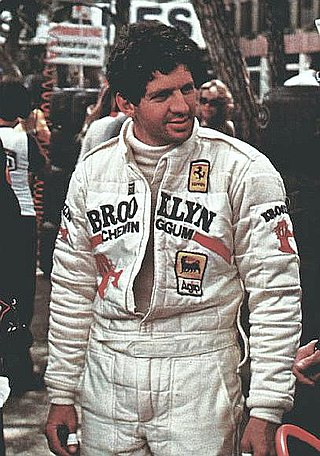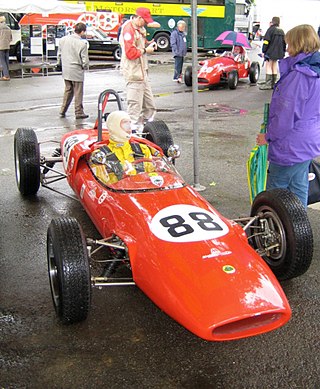The Surtees Racing Organisation was a race team that spent nine seasons as a constructor in Formula One, Formula 2, and Formula 5000.

The 1979 Formula One season was the 33rd season of FIA Formula One motor racing. It featured the 1979 World Championship of F1 Drivers and the 1979 International Cup for F1 Constructors which were contested concurrently over a fifteen-round series which commenced on 21 January 1979, and ended on 7 October. The season also included three non-championship Formula One races.

Hesketh Racing was a Formula One constructor from the United Kingdom, which competed from 1973 to 1978. The team competed in 52 World Championship Grands Prix, winning one and achieving eight further podium finishes. Its best placing in the World Constructors' Championship was fourth in 1975. Hesketh gave James Hunt his Formula One debut, and he brought the team most of its success. Alan Jones also began his Formula One career in a privately entered Hesketh.

Silvio Moser was a racing driver from Switzerland.
Bellasi is a Swiss-Italian motorsport company specialized in manufacturing composite parts for racing cars. From 1970 to 1971 it was a Formula One constructor. They participated in six grands prix, entering a total of six cars.

Kauhsen was a Formula One constructor from Germany, founded by former sportscar driver Willi Kauhsen. The team started in Formula Two in 1976, purchasing Renault cars, and raced with an assortment of drivers with limited success. Kauhsen then entered the 1979 Formula One season, spending 1978 designing their own chassis with Cosworth engines. They participated in two World Championship Grands Prix with Gianfranco Brancatelli, failing to qualify on both occasions, before the team was shut down.
March Engineering was a Formula One constructor and manufacturer of customer racing cars from the United Kingdom. Although only moderately successful in Grand Prix competition, March racing cars enjoyed much better success in other categories of competition, including Formula Two, Formula Three, IndyCar and IMSA GTP sportscar racing.

Gianfranco Brancatelli is a former racing driver from Italy.

Frank Williams Racing Cars was a British Formula One team and constructor.
Brian Roger Hart was a British racing driver and engineer with a background in the aviation industry. He is best known as the founder of Brian Hart Limited, a company that developed and built engines for motorsport use.

The Brabham BT49 is a Formula One racing car designed by South African Gordon Murray for the British Brabham team. The BT49 competed in the 1979 to 1982 Formula One World Championships and was used by Brazilian driver Nelson Piquet to win his first World Championship in 1981.

The Lotus 20 is a Formula Junior car built by Lotus for the 1961 season as a successor to the Lotus 18.

The Footwork FA12 was a Formula One car designed and built by the Footwork Arrows team for the 1991 season. The number 9 car was driven by Michele Alboreto and the number 10 car was shared by Alex Caffi and Stefan Johansson. The team had no test driver.

The Arrows A2 was a Formula One racing car, designed by Tony Southgate and Dave Wass, was used by the Arrows team in the latter half of the 1979 Formula One season. Powered by a Cosworth DFV V8 engine and driven by Riccardo Patrese and Jochen Mass, it was relatively unsuccessful with its best finish being sixth on two occasions.

Équipe Ligier is a motorsport team, best known for its Formula One team that operated from 1976 to 1996. The team was founded in 1968 by former French rugby union player Guy Ligier as a sports car manufacturer.
Silvio Moser Racing Team SA was a motor racing team from Switzerland, founded by Silvio Moser. The team was headquartered in Lugano and entered cars in Formula One and sports car racing.

The Hesketh 308C was a Formula One racing car designed by Harvey Postlethwaite and used by Hesketh Racing in the latter stages of the 1975 Formula One season. The car featured the rubber suspension which Postlethwaite had pioneered on the preceding 308B model and a Ford-Cosworth DFV engine. In 1976, the car was acquired by Wolf–Williams Racing and rebranded as the Wolf–Williams FW05.

The Matra Company's racing team, under the names of Matra Sports, Equipe Matra Elf and Equipe Matra Sports, was formed in 1965 and based at Champagne-sur-Seine (1965–1967), Romorantin-Lanthenay (1967–1969) and Vélizy-Villacoublay (1969–1979). In 1979 the team was taken over by Peugeot and renamed as Automobiles Talbot.

Willibert "Willi" Kauhsen is a German former racing driver and racing team owner from Eschweiler in Aachen, Germany.

The Williams FW was a Formula One car used by Frank Williams Racing Cars during the 1973, 1974 and 1975 seasons. It was designed by John Clarke.














